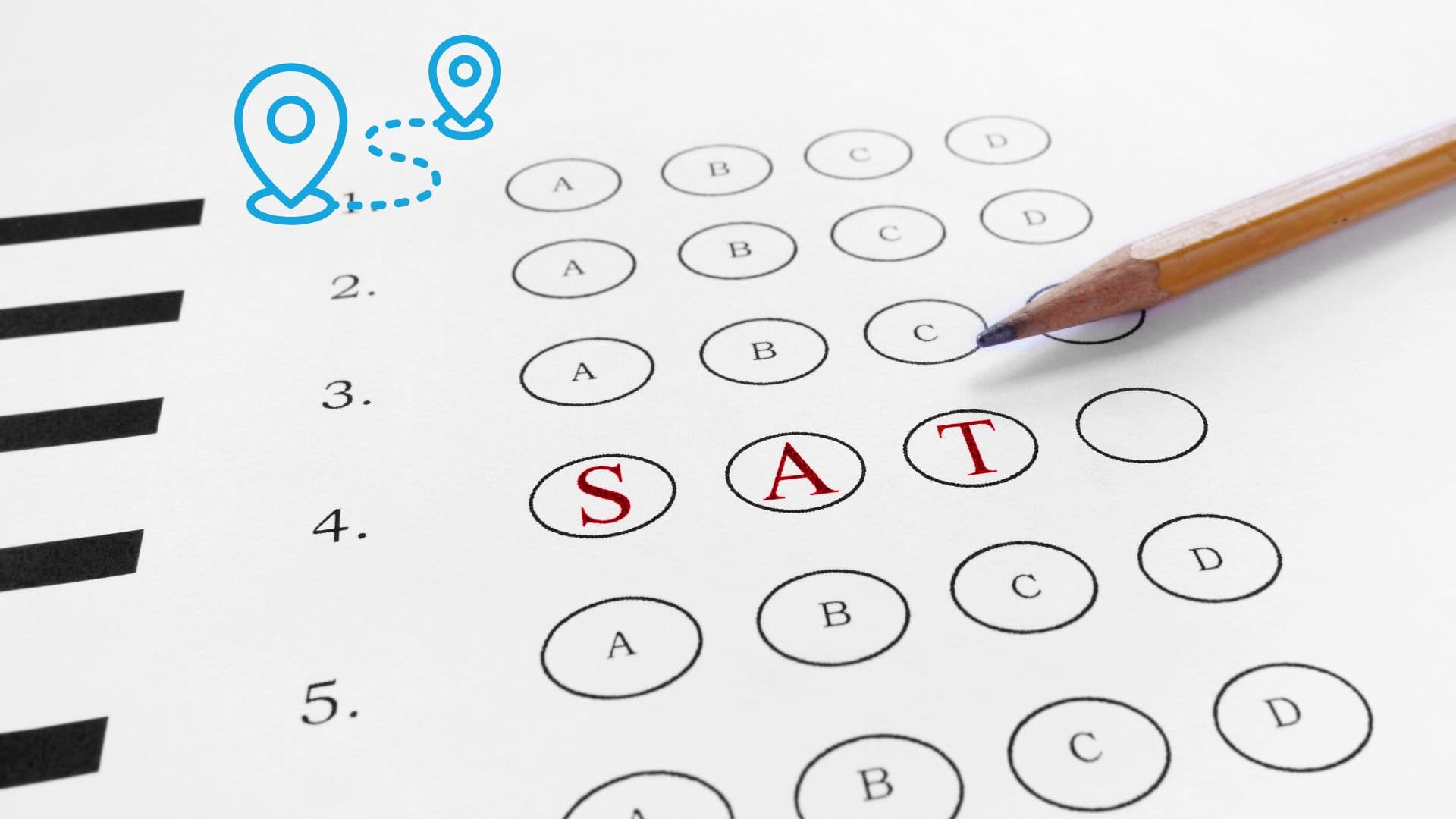
The SAT, or Scholastic Aptitude Test, is a standardized test offered by the College Board for undergraduate college admissions. Alongside ACT, the SAT is one of the two most important and popular tests for evaluating students during the admissions process for colleges in the United States. 1.9 million high school students students took the SAT in 2023 alone.
Understanding the SAT is important for anyone hoping to pursue an undergraduate degree. In this post, we will go over everything you need to know about the SAT, including what content is on the SAT, how to prepare for the SAT, how to take the SAT, and guidelines for what to do after you take the SAT. Read on for a comprehensive overview on the SAT, and use the table of contents below to jump to specific topics.

The SAT is created by the College Board, a non-profit organization with the mission of preparing students for a successful transition from high school to college and dedicated to expanding access to higher education. They developed the SAT as a way to standardize the college admission process and ensure an equal assessment opportunity for all applicants. The SAT aims to provide an objective measure that can be evaluated alongside high school grades and extracurriculars to offer a more complete and measurable picture of a student’s academic capabilities. The test aims to measure a student’s capabilities in areas like math, reading, and writing, giving colleges a standard data point to compare all applicants. The SAT is the long-standing premier standardized college admissions test in the United States, with over 1.5 million test takers in each of the last 10 years.
SAT Section | Time | Questions |
|---|---|---|
Reading, Writing & Language | 64 minutes | 54 multiple-choice questions |
Mathematics | 70 minutes | 33 multiple-choice questions, 11 grid-in questions |
Total | 134 minutes (2 hours, 14 minutes) | 98 questions |
The SAT is made up of two main sections: Reading, Writing & Language; and Mathematics. Each section is scored between 200 and 800 points and contributes equally to the composite score of 400 to 1600 points. The test doesn’t include a Science section like the ACT, but it assesses chart and graph interpretation skills across the other sections.
In the SAT Reading, Writing, & Language section, students will have 64 minutes to answer 54 questions based on short passages covering literature, history, humanities, and science topics. With the new digital SAT, each short passage corresponds to one question, which contrasts with the current ACT or the old SAT where you would read one passage and answer multiple questions. Many students find the 1:1 passage:question format of the new digital SAT easier.
The multiple-choice questions in the Reading, Writing, & Language section fall into one of four domains: Information and Ideas, Craft and Structure, Expression of Ideas, and Standard English Conventions.
Information and Ideas
These questions assess your ability to comprehend, analyze, and evaluate information in text and graphics. They require you to find, interpret, and integrate information and ideas from various sources.
Craft and Structure
This question type tests comprehension and vocabulary skills, along with your ability to understand the use of words in context, evaluate texts rhetorically, and establish connections between related texts.
Expression of Ideas
This question type asks you to revise texts to improve the effectiveness of expression and achieve specific rhetorical goals.
Standard English Conventions
These questions focus on editing texts to adhere to standard English sentence structure, usage, and punctuation rules.
In the SAT Mathematics section, students will have 70 minutes to answer 44 questions. The Math section emphasizes algebra and includes basic geometry formulas. It allows a built-in Desmos graphing calculator in the Bluebook app (the software used to take the digital test) or an approved external one. 33 questions, which account for 75% of the questions, are multiple-choice. The other 11 questions, 25% of the test, are a student-produced, “grid-in” response format.
In the Math section, both question types cover concepts from three main areas:
Algebra and Advanced Math
These questions involve analyzing and solving linear equations and inequalities, as well as equations and systems of equations, understanding and solving for absolute values, quadratic, exponential, polynomial, rational, radical, and other nonlinear equations. You can expect over 50% of the questions on the math section to cover this area.
Problem-Solving and Data Analysis
This question type tests your ability to apply quantitative reasoning about ratios, rates, proportional relationships, unit rates, and data interpretation.
Geometry and Trigonometry
These questions include solving problems related to area and volume formulas, lines, angles, triangles, right triangles, trigonometry, and circles.
The SAT takes 134 minutes without breaks, with one ten-minute break between the two sections. The content is arranged as follows:
SAT Section | Time | Questions |
|---|---|---|
Reading, Writing & Language | 64 minutes | 54 multiple-choice questions |
Mathematics | 70 minutes | 33 multiple-choice questions, 11 grid-in questions |
Total | 134 minutes (2 hours, 14 minutes) | 98 questions |
Be sure to arrive at your SAT test early, as it takes a little bit of time to get signed in and seated. You do not want to be running late and stressed out – it could throw you off of your game.
For many students and their families, the cost of taking the SAT is an important factor to consider. The basic registration fee for the SAT is currently $60. Additional costs can include late registration fees, which are $30, and change fees (if a student needs to change the test date or center), which are $25. Financial assistance and fee waivers are available for eligible students, which can alleviate the financial burden.
The difficulty of the SAT is subjective, as it depends on the individual’s strengths and level of preparedness. Each student has their own natural strengths and weaknesses, so individuals will experience differing degrees of difficulty in each tests’ subject areas. The SAT test is designed to assess readiness for college-level work, so a solid grounding in high school coursework is essential.
In the Math Section of the SAT, students often have difficulty with advanced algebra and geometry questions. This difficulty primarily arises for those who haven’t extensively covered these subjects in high school. Additionally, the time constraints pose a significant challenge, demanding fast and efficient problem-solving skills. Another unique feature of this section is the grid-in questions. Unlike the multiple-choice format, these questions require students to produce their answers, requiring a thorough understanding of the concepts and precise calculations.
The Reading, Writing and Language section of the SAT presents its own set of challenges. Students might find the nuances of English grammar and language usage particularly challenging if they struggled in those classes in high school, and this challenge is amplified for those whose first language isn’t English. Furthermore, this section tests rhetorical skills, which involve the ability to improve the organization and impact of a passage, requiring an advanced overall understanding of the language and grammar. The density and complexity of the passages can also make comprehension difficult, which is why reading The New Yorker, The Economist, or other similar magazines and newspapers is recommended when preparing for the SAT. Also, this section requires not only comprehension but critical thinking, as many questions require analysis and inference. And finally, another area of difficulty is vocabulary in context – students who aren’t regular readers or naturally lack strength in these areas may struggle to understand the best way to use words in specific contexts.
Each section of the SAT presents unique challenges, and thorough preparation is necessary for even the brightest students if you’re looking to achieve a top score.
The SAT and ACT are both standardized tests used for college admissions in the United States, but they have some distinct differences:
Number of sections
The SAT emphasizes critical thinking and problem-solving skills, and is divided into two main sections: Reading, Writing, and Language, and Mathematics. The ACT, on the other hand, focuses on a broader range of content with four sections: English, Reading, Math, and Science.
Advanced math
The ACT has slightly more advanced math in its math section, including concepts from Algebra II, Geometry, and Trigonometry. If this does not play to a student’s strengths, they might favor the SAT.
Reading passage length
The ACT Reading section includes long passages, from which students must answer multiple questions. This contrasts with the new SAT, where short passages correspond to just one question.
Science section
The ACT features a Science section, which is not present at all on the SAT. That said, the ACT Science section does not quiz test takers on scientific knowledge, and instead uniquely emphasizes understanding experiments, charts, and data, and which conclusions can be drawn from the data. The SAT’s Reading, Writing and Language section may include text from scientific articles, and the Math section may include graphs, but neither matches the style of question that you will see on the ACT Science section.
ACT vs. SAT length and time per question
Perhaps the most challenging difference between the ACT and SAT is the time difference. While both tests have significant time pressure and require quick decision-making, the ACT gives students 175 minutes to answer 215 questions, while the SAT gives 134 minutes to answer 98 questions. While the ACT and SAT provide similar information to colleges about a student’s abilities, they are very different exams. It is advisable to take practice exams for both the ACT and the SAT, and to pick the exam that best plays to one’s strengths.
The SAT and ACT follow different score systems:
The SAT score ranges from 400 to 1600, and is a combination of the scores from the two main sections, each ranging from 200 to 800.
The ACT provides a composite score, averaging the four main section scores, each ranging from 1 to 36.
To compare SAT and ACT scores, use our score comparison (concordance) chart below. This chart shows how scores on one test relate to the other in terms of your performance on the exam relative to the test taking population.
SAT Score | ACT Score | Percentile |
|---|---|---|
1530-1600 | 35-36 | 99 to 99+ |
1500 | 34 | 98 |
1450 | 33 | 96 |
1400 | 31 | 93 |
1350 | 29 | 90 |
1300 | 28 | 86 |
1250 | 26 | 81 |
1200 | 25 | 75 |
1150 | 23 | 68 |
1100 | 22 | 61 |
1030 | 20 | 50 |
990 | 19 | 43 |
940 | 17 | 35 |
890 | 16 | 27 |
830 | 15 | 19 |
790 | 14 | 13 |
740 | 13 | 7 |
690 | 12 | 3 |
620 | 10 | 1 |

The SAT is offered only on specific days that are coordinated months in advance. This is always several times a year on Saturdays. The test dates are spread throughout the academic year, giving students multiple opportunities to take and retake the test during the college application process. It is important for students and their families to plan ahead and choose a test date that allows sufficient time for preparation, and falls before they plan to send in their college applications. Please see the 2024 SAT test date and registration schedule below:
Test Date | Registration Deadline | Regular Cancellation Deadline |
|---|---|---|
August 24, 2024 | August 9, 2024 | August 13, 2024 |
October 5, 2024 | September 20, 2024 | September 24, 2024 |
November 2, 2024 | October 18, 2024 | October 22, 2024 |
December 7, 2024 | November 22, 2024 | November 26, 2024 |
March 8, 2025 | Febuary 21, 2025 | Febuary 25, 2025 |
May 3, 2025 | April 18, 2025 | April 22, 2025 |
June 7, 2025 | May 22, 2025 | May 27, 2025 |
The recommended duration for SAT preparation is generally around 2-3 months. You should plan for at least 100 hours of study, which translates to about 12 hours per week over 8 weeks, or 8 hours per week over 12 weeks. It’s crucial to schedule this study time in advance to make sure you consistently dedicate time to it. If you’re aiming for a specific test date, like one in August or October, dedicating your summer to SAT prep is a smart strategy.
The more significant the score improvement you’re aiming for, the more study time you’ll likely need. For instance, if you’re looking to boost your SAT score substantially, say by 200 points or more, you should consider studying for about six months, and be prepared to take the test multiple times.
The SAT assesses your knowledge in high school level reading, writing, and math. Your first step should be to ensure you are familiar with the key concepts in these subjects. Revisiting old notes, textbooks, and refreshing your memory on fundamental concepts is a great start.
After that, several approaches exist for preparation specifically for the SAT test. We have listed them below, organized from cheapest to most expensive:
As with any educational program, the quality of your SAT prep will vary based on the instructor or course you choose. For online courses, the software quality also plays a significant role.
One cost-effective strategy is to start with free resources paired with books or online self-study courses, and then hire a tutor for targeted assistance in weaker areas. A good online course should highlight your weak points, providing practice problems you can review on your own or with a tutor. If cost is not a concern, starting with a tutor right off the bat can offer the most personalized and effective preparation experience.

To sign up for the SAT, you need to register for a test date. Registering for the SAT is a straightforward online process:
That covers the typical SAT registration process. If you need any special accommodations due to disabilities, apply for these well in advance. College Board will communicate through email, so check your inbox regularly for updates or notifications.
The new SAT is digital, but you cannot take the exam remotely. The test must be taken at designated test locations. Students are provided laptops at the testing locations that they will use during the test.
You should bring two types of things to your SAT test day: academic essentials, which are needed for the test, and comfort items to help you get and stay in the zone. We’ll cover each in detail below. Smartphones, smartwatches and other electronic devices are strictly prohibited during the test. If you bring them, they will need to be turned off and stored away.
Academic Essentials for SAT Test Day:
When preparing for your SAT test day, it’s crucial to pack the academic essentials. These items are necessary for effectively taking the exam:
These items are required to take the test. Double-check that you have them all before you leave for the test center.
How to be comfortable on your SAT Test Day:
In addition to the academic essentials, you can bring and do these things for your comfort and well-being during the exam. The following can help manage stress and keep you focused:
These comfort items can make a significant difference in your test-taking experience. Remember, being well-prepared isn’t just about having the right tools for the test; it’s also about ensuring your focus and readiness.
After taking the SAT in 2024, you can expect most private colleges, prominent public universities, and tech schools to accept SAT scores. Over 4,000 colleges and universities worldwide accept SAT scores.
The time it takes to receive your SAT scores varies, but typically scores are available online a few weeks after the test date.

To send your SAT scores to schools, follow these steps:
Scores are sent to colleges that you designated during the signup process within 10 days of your SAT scores being released to you. If you add schools to your list after scores are released, then you should expect it to take 10 days to reach those institutions as well. Each college has its own deadline for receiving scores, so plan accordingly and make sure your scores aren’t late!
Yes. “Super scoring” is an option with multiple SAT scores, where the College Board counts your highest scores on the two respective sections from different test dates.
The number of times you can take the SAT is not strictly limited, but it is important to plan strategically and consider how many attempts are possible and practical for your college application schedule.